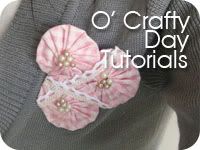We painstakingly stitched our fabric pieces using the templates that our lecturer provided, tried to tie up the threads tightly as possible (or so I thought I had + I broke a piece of thread in the process.. Sobs) and gave our fabric pieces a good dye bath. We were then told to remove the threads the next morning before hanging the pieces to dry...
And so.. I woke up late the next morning (boo hoo) and realized my pieces were already dry to the touch.
I tried using scissors to snip the threads but it was a pain. I ended up using my trusty unpicker.. And... Tadah!!!
Major fail! Except for a piece with some vague impressions, the others turned out solid blue. What a big disappointment!
Not willing to give up, I did an experiment. I stitched up 2 fabric pieces, 1 using a cotton hand-quilting thread and the other using polyester upholstery thread (both from Gütermann. I've no idea what kind of thread we used in the class..) Comparatively, the upholstery thread tangled more easily but it was quite a breeze to tie the thread ends very tightly. The hand-quilting thread, on the other hand, was harder to handle on the tying part as it was thinner and more slippery.
For the dyeing, I decided to use Dylon hand dye + microwave combo. I figured this would allow me to rinse the fabric pieces as soon as possible once out of the dye bath instead of having to wait till the next day.
And here are the results:
On the left, cotton hand-quilting thread was used. And on the right, polyester upholstery thread was used. In both pieces, the top straight-stitching portion turned out quite well. However, the smaller details are a different story. The circles and "R" could barely be seen on the quilting thread piece whereas on the other piece, the patterns are quite visible.
Here's a closer look at the visible "R" and triangle..
















No comments :
Post a Comment